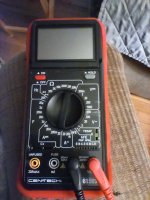Woodstock60
Petty Officer 1st Class
- Joined
- Dec 14, 2008
- Messages
- 238
I know their is a section on this in here, but my head is spinning with numbers and I'm not very good with electric testing, and I have a 5 day fishing trip coming up in 2 weeks and I'm panicked.
My problem is on this motor, suddenly no spark at all on all 3 cyl. , thought it was the stator, bought a new one , put in in carefully still no spark. Decided to test all ignition components, and I just don't know how to use one of these meters, and I can't figure out what the specs should be any way, I desperately need someone to walk me through it like I am ab6 year old. What I have been able to do is eliminate the stator and the kill switch. I need to test the trigger, the regulator \ rectifier, switch box. Thanks to anyone that can teach me. I also need to be shown what settings my meter needs to be set on, the ohms area has 7 different settings
My problem is on this motor, suddenly no spark at all on all 3 cyl. , thought it was the stator, bought a new one , put in in carefully still no spark. Decided to test all ignition components, and I just don't know how to use one of these meters, and I can't figure out what the specs should be any way, I desperately need someone to walk me through it like I am ab6 year old. What I have been able to do is eliminate the stator and the kill switch. I need to test the trigger, the regulator \ rectifier, switch box. Thanks to anyone that can teach me. I also need to be shown what settings my meter needs to be set on, the ohms area has 7 different settings




















